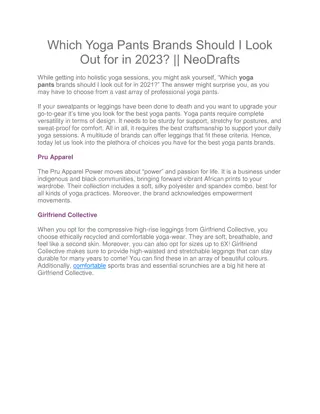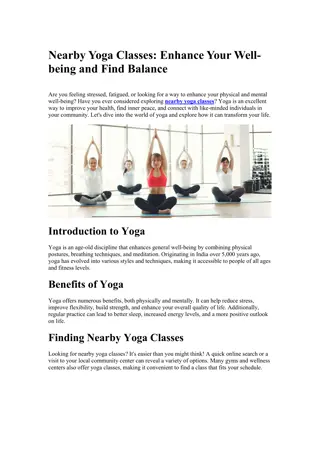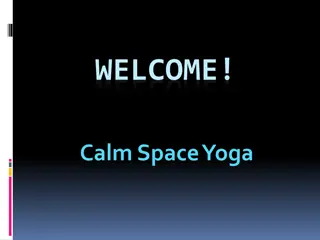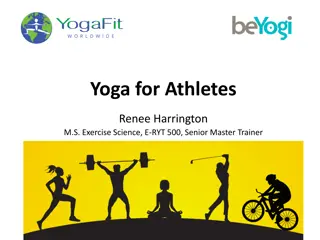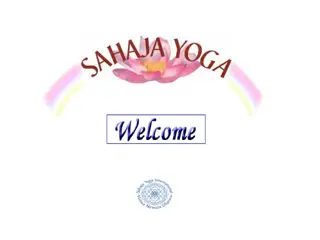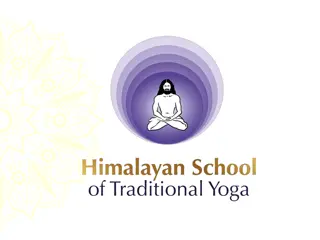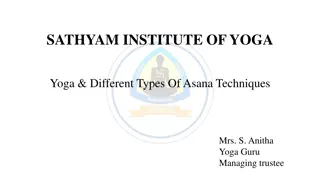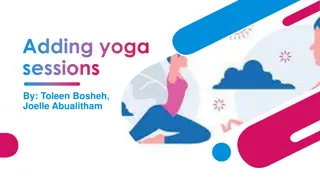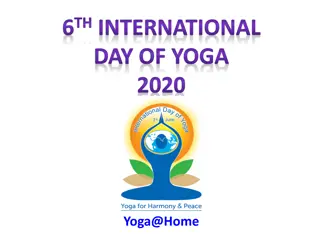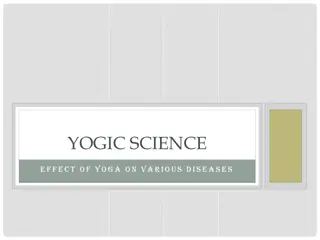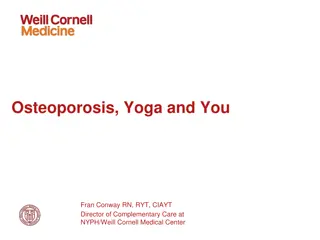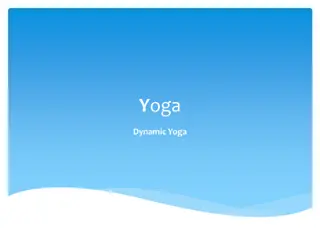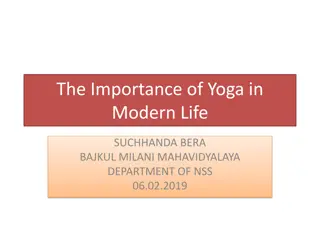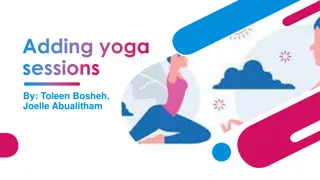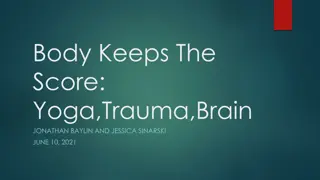Yoga Asanas Overview by Dr. Govind Martale - Director of Physical Education
Explore various yoga asanas including Tadasana, Anjaneyasana, Vrukshasan, Trikonasana, and Hasta Uttanaasana, explained by Dr. Govind Martale, Director of Physical Education at Dhanaji Nana Mahavidyalaya. Each asana is detailed with English names, muscle groups worked, joint actions, benefits, and precautions to be taken. Enhance your yoga practice with these insightful descriptions.
Uploaded on Sep 12, 2024 | 3 Views
Download Presentation

Please find below an Image/Link to download the presentation.
The content on the website is provided AS IS for your information and personal use only. It may not be sold, licensed, or shared on other websites without obtaining consent from the author.If you encounter any issues during the download, it is possible that the publisher has removed the file from their server.
You are allowed to download the files provided on this website for personal or commercial use, subject to the condition that they are used lawfully. All files are the property of their respective owners.
The content on the website is provided AS IS for your information and personal use only. It may not be sold, licensed, or shared on other websites without obtaining consent from the author.
E N D
Presentation Transcript
By Dr. Govind Sadashivrao Martale Director of Physical Education Dhanaji Nana Mahavidyalaya, Faizpur Tal. Yawal Dist. Jalgaon 425503 Mobile No. 9637105757, 8857088109 govind_martale@rediffmail.com
Tadasana English Name: - Mountain Pose Asana Type: - Standing Asanas Muscles Working: - Intrinsic and Exteinsic foot muscles, Quadriceps, Iliopsoas, Piriformis, Abdominal wall, and Diaphragm Joint Actions: Extension: - Liumbar, Thoracic, Cervical Curves Neutral: Ankle, Hip, Shoulder Wrist joints Extended: Knee and elbow joints Lifting Action: Arches of the feet, the pelvic floor, lower abdomen, rib cage, cervical spine, the top of the head Strengthens Thighs, knee and Ankles, Relieves Sciatica, Reduces flat feet Avoid this asana: - Headaches, Insomnia and Low blood pressure
Anjaneyasana Hanuman s Mother name English Name: - Crescent Pose Asana Type: - Standing Muscles Stretched: - Iliopsoas, Quadriceps, Gluteus Maximus Muscles Working: - Legs: gluteus Medius, Gluteus Minimus Adductor magnus, Adductor Longus, Adductor Brevis, Gracilis, Pectineus Arms & Shoulders: - Deltoids, Triceps, Trapezius, Rhomboid and Latissimus Dorsi Joint Actions: - Hip flexion, Opposite Side hip extension, Hip adduction, Spinal extension, Shoulder abduction Strengthens Knee Joint Avoid this asana: - If you have High blood pressure, Knee injuries If you have Shoulder problems and neck problem avoid raising your arms above head
Vrukshasan English name: - Tree Pose Anatomical focus: - emphasize alignment of the head, spine and hips Increases the range of motion in the hips Tones the muscles of the legs, back and chest Strengthens the ankles
Trikonasana English Name: - triangle Pose Stretches: - Ankles, Groin, Thighs, Shoulders, Knees, Hips, Calves, Hamstrings, Thorax, Vertebral column Strengthens: - Ankles, Thighs, Knees legs, chest and arms Helps reduce back pain and Sciatica Reduces Stress and Cures anxiety
Hasta Uttanaasana English Name: - Ralsed Arms Pose, Ralsed Hands Pose, Hand Raising Pose, Sky Reaching Pose Hast = Hand Uttana = intense stretch, Extension, Straight or Stretched This pose is use in Surya Namaskar Abdomen organs stretched This asana helps to relax the neck and back muscles Useful for Frozen shoulders Thyroid gland affected which helps in fighting Obesity
Padmasana Sanskrit word Padma: Lotus Improve digestion Reduces Muscular tension and brings blood pressure under control Reduces female menstrual disorders connected with the reproductive organs It helps in improving concentration It bring peace, solitude and longevity to the practitioner.
Vajrasana English Name: - Kneeling pose, Thunderbolt or Diamond pose Stretches: - Ankles, Thighs,knees and Hips This asana help in digestive system It also strengthens the muscles of legs and back Helps in reduction of the hips Helps to fight stomach disorder Mind calming Increasing the blood circulation Avoid this asana: - Knees Problem or surgery (recently), Suffering from any spinal column ailment on the lower vertebrae, suffering from intestinal Ulcers, Hernia, Small Intestine
Balasana English Name: - Child s Pose, Child s resting pose Bala = Child and asana = posture Stretches: Hip, Thigh, Ankle Strengthens: - Back, Neck and Shoulder It helps to massage and flex the internal organs Helps to stretch and lengthen the spine Relieves pin in the lower back and neck Promotes blood circulation all throughout the body The tendons , muscles, Ligaments in the knee area are thoroughly stretched
Anahatasana Melting Heart pose, Extended Puppy pose Compression along the spine stimulates the Urinary bladder lines This posture can juice up the arm meridians, especially the heart and lung
Baddha Konasana English Name: - Bound Angle Pose, or Cobbler Pose Stretches: - Knee, thighs, Groin Strengthens: - Hips, Legs, Lower Back and Abdomen Improves flexibility in the inner thighs, groins and the knees Stimulates the abdominal organs, potentially improving the ovaries, prostate gland, kidneys and bladder Avoid this asana: - Knee injury and suffer from sciatica
Janusirsasana English Name: - Head to Knee pose, Head to Knee Forward bend, Head of the knee pose or Head on Knee pose Strengthening and Stretching the shoulders, Spine, Groins, and Hamstrings Strengthens: - Back Stimulation the Liver and Kidneys Improving Digestive System Therapeutic for high blood pressure, insomnia and sinusitis Avoid this asana: - Diarrhea or Asthma, Knee injury, Lumbar disc herniation and Lower back injury
Paschimottanasana English Name: - Seated forward bend or Intense Dorsal Stretch Paschima = west/ Back, Uttana = Intense stretch Asana = Pose Useful for diabetes and High blood pressure Stretches: - vertebral column, Shoulders, Hamstrings It helps improve digestive systems Kidneys, Liver, Uterus and Ovaries are activated Strengthens: - Back and Spine Avoid this asana: - Diarrhea or Asthma, Knee injury, Lumbar disc herniation, Lower back injury and Pregnant Women must avoid
Ardha matsyendrasana English Name: - Half Lord of the Fishes Pose, Half Spinal Twist Pose Ardha = Half Matsyendra = King of the Fish Matsya = Fish and Indra = Ruler Stretches: - Hips, Shoulders, Neck Strengthens: - Spine, Digestive System, Urinary System and Reproductive System Increases the elasticity of the Spine Increases the oxygen Supply to the Lungs Avoid This Asana: - Severe Slipped Dise Problem, Pregnant Women, Recently undergone abdominal,
Marjaryasana English Name: - Cat pose Marjari = cat Stretches the back torso and neck Provides a gentle massage to the spine and belly organs Helps regulate blood circulation throughout body Helps relive stress Avoid this poses: - Severe Neck or Head injury
Bitilasana English Name: - Cow pose Stretches the back torso and neck Provides a gentle massage to the spine and belly organs Helps regulate blood circulation throughout body Helps relive stress Avoid this poses: - Lower back injury
Chakki Chalanasana English Name: - Mill Churning pose Chakki = Grinder, Chalana = Drive Benefits: - 1) Prevent sciatica nerve pain, 2) Helps to tone the back, arms and groin 3) Helps to women menstrual problems 4) Excellent exercise for toning the nerves and organs of the abdomen and pelvis 5) first three months of pregnancy In case of any surgery for stomachache avoid this poses
Shalabhasana Type of asana: - Lying on Abdomen pose Meaning: - Locust or Grasshoper Concentration: - On the musckesof the legs and back and the Manipura Chakra Benefits: - 1) Kidney function is stimulated 2) Leg, pelvic and back muscles are strengthened 3) Lower end of the spine 4) Most helpful for backache sciatica pain 5)Encourages good posture and a slim figure 6) Removing unwanted fats around abdomen, waist, hips and thighs 7) Cures cervical spondylitis and spinal cord ailments 8) Beneficial for depression and Develops self confidence In case of any surgery for stomachache and lower back avoid this poses First of all practice Ardha Shalabhasana
Naukasana Type of asana: - Lying on Abdomen pose English Name: - Boat Pose Strengthens the back, abdominal, Thigh, Hips, Necks and Shoulder muscles Tones the leg and arm muscles Useful for people for people with Kidney function, Thyroids and prostate glands Regulates the function of pancreas, liver and lungs. Reduce belly fat and Developing six pack ABS Avoid the pose: - 1) Low and High blood pressure 2) Severe headache, Migraine 3) Hip joint pain, Arthritis 4)Pregnant Women
Makara Adho Mukha Svanasana Type of asana: - Lying on Abdomen pose English Name: - Dholpin Plank Pose Effectively relives the body of headache, Fatigue and Back-ache Strengthens the arms and legs Tone the abdominal muscles Improves digestion Relieves menstrual discomfort Back injury, Neck injury or Spinal injury perform this pose with the supervision Avoid this pose: - 1) Recent shoulder, back arm or neck injury 2) High blood pressure
Sarpasana Type of asana: - Lying on Abdomen pose Sarp = Snake and asana = Pose it means Snake pose Strengthens the lung, heart, and Legs Strengthens the four parts of the heart are Endocardium, Epicardium, Myocardium and Pericardium. So that the heart diseases will go off. Helps to all organs of abdomen get proper massage Makes spine more flexible, prevents slip disk, cervical and back pain Avoid this pose: - Hernia, Hyperthyoidism, High blood pressure, Peptic Ulcer, Intestinal Tuberculosis, Pregnancy
Bhujangasana Type of asana: - Lying on Abdomen pose and back bending pose English Name: - Cobra Pose Stretches: - Abdomen, Shoulders Thorax and Lungs Strengthens: - Vertebral columns Benefits: - Spine stronger and more flexible, It also organs that lie in the lower abdomen, It stimulates the digestive, reproductive and Urinary systems, This asana is known to open up the lungs and the heart, It relieves sciatica and Asthma Avoid this pose: - Hernia, Back injury, Carpal tunnel syndrome, Headaches, Pregnancy and Recently abdominal surgeries
Dhanurasana Type of asana: - Lying on Abdomen pose English Name: - Sanskrit: ; Bow Pose, or sometimes UrdvaChakrasana (Upward Wheel Pose) is an asana. Benefits of Bow Pose (Dhanur sana):- 1) Strengthens the back and abdominal muscles. 2) Stimulates the reproductive organs. 3) Opens up the chest, neck and shoulders. 4) Tones the leg and arm muscles. 5) Adds greater flexibility to the back. 6) Good stress and fatigue buster. 7) Relieves menstrual discomfort and constipation. 8) Helps people with renal (kidney) disorders. 9) It provides relief from headache. Stretches: Abdomen, Thorax, Thighs, Ankles, Groin, Psoas major muscle, Throat, Front of the body Do not practice Dhanurasana(Bow Pose) if you have: High or low blood pressure Hernia Neck injury Pain in the lower back Headache migraine Recent abdominal surgery Ladies should avoid practicing this yoga pose during pregnancy.
Type of asana: - Lying on Back pose English Name: - Wind-Relieving Pose, Wind Removing Pose, or Wind Liberating Pose is an asana. Sanskrit: ; Pawan wind, Mukta relieve or release, Asana pose Benefits It cures acidity Indigestion and Constipation. It is very good for all abdominal organs. Regular practice pavanamuktasana cures gastrointestinal problems. Helpful for those suffering from gas problems, acidity, arthritis pain, heart problems and waist pain. Strengthens back muscle and cures back pain. It gives flat stomach. Everyone should practice this asana for flat stomach. It is very beneficial for reproductive organ and for menstruation disorder. Avoid this pose: - 1) People with injured or weak knees should not practice Supta Pawanmuktasana or The Reclined Wind Relieving Pose as a lot of stress is put on the knees. 2) People with back ache and sciatica should not practice Supta Pawanmuktasana or The Reclined Wind Relieving Pose. 3) You should also avoid practicing Supta Pawanmuktasana or The Reclined Wind Relieving Pose if you have an injury to the ankle. 4) Get out of the pose or release the pose if you feel a sudden sharp and shooting pain in your legs. 5) If you have any doubts about your condition, consult a physician before practicing Supta Pawanmuktasana or The Reclined Wind Relieving Pose and always practice asana under the supervision of a trained yoga expert. 6) Do not over exert yourself while practicing Supta Pawanmuktasana or The Reclined Wind Relieving Pose. Do not push yourself beyond the limits. Go only as far as your body allows. 7) Supta Pawanmuktasana or The Reclined Wind Relieving Pose should not be practiced if you have frequent headaches and migraine. 8 ) You should also not perform Supta Pawanmuktasana or The Reclined Wind Relieving Pose if you have any chronic spinal or neck problems. 9) Pregnant women should also not perform Supta Pawanmuktasana or The Reclined Wind Relieving Pose. 10) People suffering from peptic ulcer, hernia, intestinal tuberculosis and other such conditions are also advised not to practice Supta Pawanmuktasana or The Reclined Wind Relieving Pose. 11) People with neck injury are advised to look down on the floor and keep the head in a neutral position while practicing Supta Pawanmuktasana or The Reclined Wind Relieving Pose. 12) People with heart problems like chronic thrombosis should also not practice Supta Pawanmuktasana or The Reclined Wind Relieving Pose. 13) People with High Blood Pressure should also not practice Supta Pawanmuktasana or The Reclined Wind Relieving Pose. 14) Supta Pawanmuktasana or The Reclined Wind Relieving Pose should not be performed if you have any injury or pain in the ankle. Supta pavan Muktasana
Pavan Muktasan Type of asana: - Lying on Back pose Stretches: Abdomen, Lower Back, Arms Strengthens: Back, Digestive System, Reproductive System This asana must be avoided if you have had an abdominal surgery recently. Also, people suffering from hernia or piles must avoid this asana. This asana must not be practiced by pregnant women. Menstruating women can avoid this asana if they are not comfortable. If you are suffering from heart problems, hyperacidity, high blood pressure, slip disc, hernia, back and neck problems, or a testicle disorder, you must avoid this asana. If you have had a neck injury, but have a doctor s approval to practice this asana, your head must remain on the floor as you practice it.
Naukasan Type of asana: - Lying on Back pose English Name: - Boat Pose The body come into a V-shape Strengthens the back, abdominal, Thigh, Hips, Necks and Shoulder muscles Tones the leg and arm muscles Useful for people for people with Kidney function, Thyroids and prostate glands Regulates the function of pancreas, liver and lungs. Reduce belly fat and Developing six pack ABS Avoid the pose: - 1) Low and High blood pressure 2) Severe headache, Migraine 3) Hip joint pain, Arthritis 4)Pregnant Women
Type of asana: - Lying on Back pose English Name: - Bridge Pose; Sanskrit: ; Setu Bridge, Bandha Bind/Lock, Asana Pose/Posture Benefits of Bridge Pose: Stretches the chest, neck, spine, and hips Strengthens the back, buttocks, and hamstrings Improves circulation of blood Helps alleviate stress and mild depression Calms the brain and central nervous system Stimulates the lungs, thyroid glands, and abdominal organs Improves digestion Helps relieve symptoms of menopause Reduces backache and headache Reduces fatigue, anxiety, and insomnia Rejuvenates tired legs Relieves symptoms of asthma and high blood pressure Therapeutic for hypertension, osteoporosis, and sinusitis Avoid this pose: - People who are suffering from a neck injury must either completely avoid this asana, or do it with a doctor s permission under a certified yoga instructor. Pregnant women may do this asana, but not to the full capacity. They must do it under the guidance of a yoga expert. If they are in their third trimester, they must do this asana with a doctor s consent. If you have back problems, you must avoid this asana. Setubandhasana
Paschimottanasana English Name: - Seated Forward Bend, or Intense Dorsal Stretch; Sanskrit: ; Benefits: - 1) Stretches the whole spine specifically lower back, hamstring and hips. 2) Massages and tones the abdominal and pelvic organs. 3) Improves the circulation. 4) Stretches and strengthens the calf and thigh muscles. 5) Activates the spinal nerves 6) Tones the arms 7) Reduces abdomen fat Therapeutic applications: - 1) Obesity 2) Indigestion 3) Less height 4 ) Useful for people who feel less energetic. Stretches: Vertebral column, Shoulders, Hamstrings Strengthens: Back, Spine Avoid this asana: - Avoid this asana if you have asthma or diarrhea. In case you have a back injury, you must make sure to practice this asana only under the guidance of a certified yoga instructor. Pregnant women must avoid practicing this asana.
Type of asana: - Lying on Back pose/ Supine position English Name: - Raised legs yoga pose Weight Loss: This is one of the important yoga poses for weight loss, especially the lower belly fat. It helps to burn the fat of lower belly region and lower abdominal sides. Yoga for abs: If you want to make your six pack abs, no need to hit the GYM, do it naturally with the help of this asana. Doing this yoga pose for one month and maintaining it for suitable time helps to shed the extra fat from the entire abdominal region and leads to developing a better and smart look to your body. Back pain: Initially, it may give you some pain in the lower spine, but practicing this asana regularly will help to strengthen your back. It is also good for hips and thighs. Hernia: It is effective for those who are having the problem of Hernia. In fact, it is one of the best yoga poses for hernia treatment. Balances the navel. Now and then, people are facing the problem of naval displacement. This yoga helps in balances the naval (Nabhimanipurcakra) and helps you to overcome the condition. Weak legs: It helps to make your legs stronger. Abdominal muscles: Those who have weak abdominal muscles should practice this yoga exercise. It helps to strengthen your inner abdominal finer muscles thereby ensure smooth digestion. Nervousness: It is one of the important yoga pose to overcome nervousness. Digestion: It helps to release adequate amount of gastric juices, enzymes; thus ensures better digestion and prevents indigestion, acidity, constipation and flatulence. Gas release: It is quite powerful yoga exercise to release abdominal as well as intestinal gases. A person, who is facing gas problem, should practice this yoga on regular basis. Utan Padasana
Type of asana: - Lying on Back pose/ Supine position English Title: - Supine Spinal Twist Yoga Pose Sanskrit Title: - Supta Matsyendrasana I, Prasarita Merudandasana, Jathara Parivrtti, Supta Parivartanasana All Titles: - Supine Spinal Twist Yoga Pose I, Supta Matsyendrasana I, Prasarita Merudandasana, Jathara Parivrtti, Supta Parivartanasana, Belly Twist Pose Level: - Beginner Pose Position: - SupinePose Type: - Twist, Stretch General Benefits Improves the flexibility of the spine at the lower back: Acts as a great preparatory pose for Ardha Matsyendrasana: A good Restorative pose for keeping the mind calm and reducing insomnia: Improves digestion with the proper functioning of the abdominal organs: Tones the hips and the tummy: Reduces the stress at the lower back with prolonged sitting: Avoid this pose : - 1) Injury at the lower back close to the sacrum 2)Pregnant women should use support 3) Injury at the hips or knee: Suptamerudandasana
Shavasana This pose resembles the posture of a dead body and is, therefore, named after it. Shava ( , ava) meaning corpse , and Asana ( , sana) meaning posture or seat . Benefits: - 1. Brings The Body To A Meditative State 2. Relaxes And Calms The Body 3. Reduces Blood Pressure And Anxiety 4. Improves Concentration And Memory 5. Increases Levels Of Energy Avoid this pose: - unless your doctor has advised you, for some medical reason, to avoid lying on your back.
Thank you Thank You Thank You





